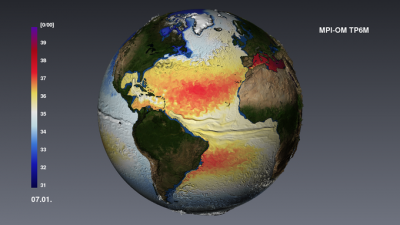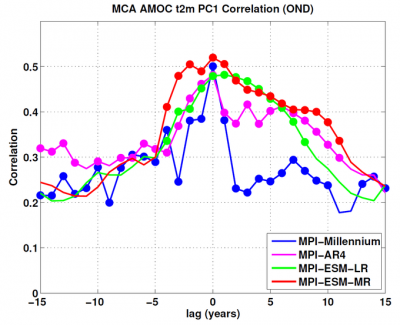Page path:
- Home
- Research
- Ocean and Climate
- Projects & Collaborative Groups
- RACE
- Theme 3
- WP3.4: High resolution initialised decadal forecasts of Atlantic and European climate variations (HIPRED) - RACE2
WP3.4: High resolution initialised decadal forecasts of Atlantic and European climate variations (HIPRED) - RACE2
PIs:
Johann Jungclaus, MPI für Meteorologie, Hamburg, johann.jungclaus(at)mpimet.mpg.de
Daniela Matei, MPI für Meteorologie, Hamburg, daniela.matei(at)mpimet.mpg.de
Jin-Song von Storch, MPI für Meteorologie, Hamburg, jin-song.von.storch(at)mpimet.mpg.de
Jochem Marotzke, MPI für Meteorologie, Hamburg, jochem.marotzke(at)mpimet.mpg.de
Team:
Helmuth Haak, MPI für Meteorologie, Hamburg
Johann Jungclaus, MPI für Meteorologie, Hamburg, johann.jungclaus(at)mpimet.mpg.de
Daniela Matei, MPI für Meteorologie, Hamburg, daniela.matei(at)mpimet.mpg.de
Jin-Song von Storch, MPI für Meteorologie, Hamburg, jin-song.von.storch(at)mpimet.mpg.de
Jochem Marotzke, MPI für Meteorologie, Hamburg, jochem.marotzke(at)mpimet.mpg.de
Team:
Helmuth Haak, MPI für Meteorologie, Hamburg


Salinity field at 75m depth in the STORM MPI-OM TP6m Modell.
Correlation coefficient at a function of lag between the first AMOC MCA Mode and the 2m air temperature variations over the North Atlantic region in various model configuration at different resolution. The circles show values that are significant at levels lower than 5 %. The ocean is leading for positive lags, while the atmosphere leads for negative lags (Niesel and Matei, in preparation).
The ultimate aim of this project is to investigate the interannual-to-decadal variability and predictability of the North Atlantic circulation and of the surrounding continental regions (Europe, Nordic Seas) using a coupled model system with an extremely high resolution in the ocean component.
Sensitivity studies and analyses of existing model simulations (hindcasts and forecasts) are carried out to investigate the role of the oceanic processes and of the ocean-atmosphere interactions in coarse-resolution, “eddy-permitting”, and “eddy- resolving” ocean model configurations. It is expected that an improved representation of the ocean dynamics as well as of the gyres and frontal regions (top Fig.) will lead to better climate predictions over the next decade. The model configuration consists of the ECHAM6 atmospheric model and an ocean model with a resolution ranging from an "eddy-permitting" (0.4°, MPIOM-TP04) to an "eddy-resolving" (0.1°, MPIOM-TP6M) setup. Analyses of already existing long-term control simulations (bottom Fig.) have shown that the varied representations of oceanic, atmospheric circulation and air-sea interactions' strength translates into different variability and signal propagation characteristics, and consequently on different levels of predictability.
The high-resolution decadal prediction experiments will be restricted to the first two decades of the 21st century (Argo period), to benefit from the inclusion of a greatly improved subsurface ocean data coverage in the upper 2000m in the ocean synthesis products used to generate the initial conditions. Having an "eddy-resolving" ocean resolution will allow us to focus not only on the predictability of large-scale features, such as basin-wide temperature, and large-scale mechanisms, such as Atlantic Meridional Overturning Circulation and heat transport, but also on smaller-scale processes: such as eddy-driven heat and salt transports, air-sea interactions over important hot-spot areas like the North Atlantic frontal and Subpolar Gyre regions.
Sensitivity studies and analyses of existing model simulations (hindcasts and forecasts) are carried out to investigate the role of the oceanic processes and of the ocean-atmosphere interactions in coarse-resolution, “eddy-permitting”, and “eddy- resolving” ocean model configurations. It is expected that an improved representation of the ocean dynamics as well as of the gyres and frontal regions (top Fig.) will lead to better climate predictions over the next decade. The model configuration consists of the ECHAM6 atmospheric model and an ocean model with a resolution ranging from an "eddy-permitting" (0.4°, MPIOM-TP04) to an "eddy-resolving" (0.1°, MPIOM-TP6M) setup. Analyses of already existing long-term control simulations (bottom Fig.) have shown that the varied representations of oceanic, atmospheric circulation and air-sea interactions' strength translates into different variability and signal propagation characteristics, and consequently on different levels of predictability.
The high-resolution decadal prediction experiments will be restricted to the first two decades of the 21st century (Argo period), to benefit from the inclusion of a greatly improved subsurface ocean data coverage in the upper 2000m in the ocean synthesis products used to generate the initial conditions. Having an "eddy-resolving" ocean resolution will allow us to focus not only on the predictability of large-scale features, such as basin-wide temperature, and large-scale mechanisms, such as Atlantic Meridional Overturning Circulation and heat transport, but also on smaller-scale processes: such as eddy-driven heat and salt transports, air-sea interactions over important hot-spot areas like the North Atlantic frontal and Subpolar Gyre regions.


